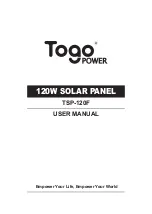
3
Safety Precautions
General Information
The installation of solar modules requires a
great degree of skill and should only be
performed by qualified licensed professionals,
including,
without
limitation,
licensed
contractors and electricians.
WARNING
All instructions should be read and
understood before attempting to install,
wire,
operate,
and
maintain
a
photovoltaic module.
Contact with electrically active parts of
the module such as terminals can result in
burns, sparks, and lethal shock whether
the module is connected or disconnected.
The installer assumes the risk of all injury
that might occur during installation,
including, without limitation, the risk of
electric shock.
The modules generate DC (direct current)
electrical
energy
when
exposed
to
sunlight or other light sources. Even a
single module produces enough voltage
and current, to cause shocks and burns if
safety precautions are not followed.
The shock hazard increases as modules
are connected in parallel, producing
higher current, and as modules are
connected in series, producing higher
voltages.
Do not hit the back sheet of a module by
the connector or other things.
To avoid the hazard of electric sparks,
shock, fire, burns, damage and injury:
Work only in dry conditions, with dry
modules and dry tools.
In order to avoid submerging cables and
connectors in the water, cables must be
fixed either to the module frame using
cable fixing holes or to the mounting
structure.
Do not stand or step on modules. Do not
puncture, cut, scratch or damage the
backsheet
of
a
module.
Backsheet
damage will void a module’s Limited
Warranty and may cause fire. Never use
modules with a damaged back sheet.
Do not allow children and unauthorized
persons near the installation or storage
site of modules.
Completely ground all modules.
Do not disassemble a module, attempt
any repair, open the junction box cover,
nor remove any parts installed by
Panasonic. There are no user serviceable
parts within the module or junction box.
Unauthorized
persons
-
except
the
qualified licensed professional - should
not
perform
any
electrical
work,
including wiring,
Wear suitable clothing, guards, eye
protection and gloves to prevent you
from direct contact with 30 VDC or
greater.
Wear non-slip gloves and carry modules
by the frame using both hands. Do not
attempt to carry a module by yourself.
Do not carry a module by its wires or
junction box.
Do not drop anything on the surface of a
module.
Ensure
all
system
components
are
compatible, and they do not subject the
module
to
mechanical
or
electrical
hazards.
Sparks may occur; do not install modules
where flammable gases or vapors are
present.
Never rest or leave a module unsupported
or unsecured.
Do not drop modules.
Do not use or install broken modules.
Do not artificially concentrate sunlight on
a module.
Do not touch the junction box terminals.
Do not change the wiring of bypass
diodes.
Do not touch a module unnecessarily. The
glass surface and frames get hot. There is
a risk of burn.
CAUTIONS
Use a module for its intended purpose
only.
Do not treat the back sheet, frame, or
front surface with paint or adhesives, to
avoid reducing its’ functionality, damage,
and causing inoperable conditions, and
other unknown troubles.
Do not insert PV cable between back side
and mounting structure rail.
GENERAL SAFETY
Follow all permissions, installation and
inspection requirements.
Before installing modules, contact the
appropriate authorities having jurisdiction
to determine permissions, installation and
inspection requirements, which should be
followed.
Electrically ground modules for all systems
of any voltage. If not otherwise specified,
it is recommended that requirements of
the latest National Electrical Code (USA)
or Canadian Electric Code (Canada) or
other national or international electrical
standards be followed. Refer to “Earth
Ground
Wiring”
section
for
more
information.
Be sure that the building or structure
(roof, façade, etc.) where the modules are
being installed has enough strength to
support the load of the modules.
For modules mounted on roofs, special
structures may be required to help
provide proper installation support.
The fire rating of this module is valid only
when mounted in the manner specified in
the mechanical mounting instructions.
Both, roof construction and module
installation design have an effect on the
fire resistance of a building. Improper
installation may contribute to fire hazards.
The models in this instructions are suitable
to maintain the System Fire Class Rating A
when used with a Listed mounting system
and a roof covering that have been rated
as a Class A System when installed on a
steep slope roof and/or a low slope roof
with "Type 2" modules.
Additional devices such as ground fault,
fuses, and disconnects may be required.
Do
not
use
modules
of
different
specifications in the same system.
Follow all safety precautions of other
system components which are used.
UL Listing Information
To satisfy UL requirements, when installing
the modules, be sure to:
1)
Use only stranded or solid copper single–
conductor sunlight-resistant cable rated
for outdoor use (e.g. type UF or USE) , for
all wiring that is exposed to weather.
2)
Observe the requirements described in
sections
labeled
INSTALLATION
and
SPECIFICATIONS.
INSTALLATION
General
Please read this guide completely before
installing or using your Panasonic PV modules.
This section contains important electrical and
mechanical specifications.
Modules should be firmly fixed in place in
a manner suitable to withstand all
expected loads, including wind and snow
loads.
Metals used in locations that are exposed
to moisture shall not be employed alone
or in combinations that could result in
deterioration or corrosion.
Install modules where they are not
shaded by obstacles like buildings and
trees. Pay special attention to avoid
partially shading the modules by objects
during the daytime.
If
needed,
contact
an
Authorized
Representative with questions regarding
mounting profiles for Panasonic HIT
®
.
Notes on Installation
Clearance between the roof surface and
module frame is required to allow cooling
air to circulate around the back of the
module. This also allows any condensation
or moisture to dissipate. The required
clearance between the roof surface and
the module is more than 4 inch.
Panasonic recommends the installation
method and mounting profile shown in
Figure 1-1 and Figure 1-2.
Figure 1-1 shows that a module should be
attached on a mount or support structure
rail by corrosive-resistant metal clamps.





























